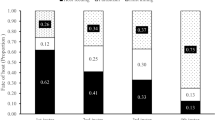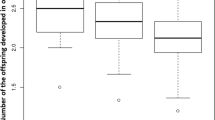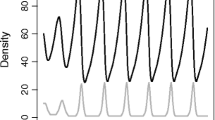Summary
Until now, mathematical models of parasitoid-host interactions have not incorporated the tendency for destructively host-feeding parasitoids to partition their feeding and oviposition behaviour in relation to different host stages. A literature survey reveals a trend for female parasitoids to feed preferentially or exclusively on earlier host stages and to oviposit preferentially or exclusively in/or later ones.
We explore the relative advantages to host-feeding parasitoids of a number of possible host stage selection strategies. We develop hypotheses, formalizing and testing them using modifications to our earlier simulation model of host-feeding strategies (Jervis and Kidd, 1986).
We conclude from our modelling that the advantage to be gained from feeding on early host stages and ovipositing in late ones is likely to be associated with: 1) reduced handling times when feeding on early stage hosts; 2) reduced wastage of progeny from mortality factors other than host-feeding by the parent parasitoid, achieved by confining oviposition to late host stages; and 3) reduced probability of progeny mortality resulting from the parent's host-feeding activities.
Similar content being viewed by others
References
Abdelrahman, I. (1974) Studies in ovipositional behaviour and control of sex inAphytix melinus DEBACH, a parasite of california Red Scale,Aonidiella aurantii (MASK.).Aust. J. Zool. 22: 231–247.
van Alphen, J. J. M. (1980) Aspects of the foraging behaviour ofTetrastichus asparagi Crawford andTetrastichus spec. (Eulophidae), gregarious egg parasitoids of the asparagus beetlesCrioceris asparagi L. andC. duodecimpunctata L. (Chrysomelidae) I. Host-species selection, host-stage selection and host discrimination.Neth. J. Zool. 31: 504–532.
van Alphen, J. J. M., H. W. Nell and L. A. Sevenster-van der Lelie (1976) The parasite-host relationship betweenEncarsia formosa Gahan (Hymenoptera: Aphelinidae) andTrialeurodes vaporariorum Westwood (Homoptera: Aleyrodidae). VII. The importance of host-feeding as a mortality factor in greenhouse whitefly nymphs. Bull. O.I.L.B./S.R.O.P.4: 165–169.
Askew, R. R. (1971)Parasitic Insects. Heinemann, London.
Askew, R. R. (1975) The organisation of chalcid-dominated parasitoid communities centred upon endophytic hosts. 130–153. In P. W. Price (ed)Evolutionary Strategies of Parasitic Insects and Mites. Plenum, New York.
Bai, B. and M. Mackauer (1990) Oviposition and host-feeding patterns inAphelinus asychis (Hymenoptera: Aphelinidae) at different aphid densities.Ecol. Ent. 15: 9–16.
Bartlett, B. R. (1964) Patterns in the host-feeding habit of adult Hymenoptera.Ann. Ent. Soc. Amer. 57: 344–350.
Cate, R. H., R. D. Eikenbary and R. D. Morrison (1977) Preference for and effect of greenbug parasitism and feeding byAphelinus asychis.Env. Entomol. 6: 547–550.
Charnov, E. L., R. L. Los-Den Hartogh, W. T. Jones and J. van den Assem (1981) Sex ratio evolution in a variable environment.Nature, Lond. 289: 27–33.
Charnov, E. L. and D. W. Stephens (1988) On the evolution of host selection in solitary parasitoids.Am. Nat. 132: 707–722.
Chua, T. H. and V. A. Dyck (1982) Assessment ofPseudogonatopus flavifemur E. and H. (Dryinidae: Hymenoptera) as a biological agent of the Rice Brown Planthopper. InProc. Int. Conf. Pl. Prot. in Tropics, March 1982: 253–265.
Cole, R. L. (1967) A study of the life-cycles and hosts of some Ichneumonidae attacking pupae of the green oak-leaf roller moth,Tortrix viridana (L.) (Lepidoptera: Tortricidae) in England.Trans. R. Ent. Soc. Lond. 119: 267–281.
Collins, M. D., S. A. Ward and A. F. G. Dixon (1981) Handling time and the functional response ofAphelinus thomsoni, a predator and parasite of the aphidDrepanosiphum platanoidis.J. Anim. Ecol. 50: 479–487.
Cook, R. M. and S. F. Hubbard (1977) Adaptive searching strategies in insect parasites.J. Anim. Ecol. 46: 115–125.
DeBach, P. (1943) The importance of host-feeding by adult parasites in the reduction of host populations.J. Econ. Ent. 36: 647–658.
Force, D. C. (1975) Succession ofr andK strategists in parasitoids. 112–129. In P. W. Price (ed)Evolutionary Strategies of Parasitic Insects and Mites. Plenum, New York.
Godfray, H. C. J. and M. P. Hassell (1988) The population biology of insect parasitoids.Sci. Prog., Oxf. 72: 531–548.
Green, R. F. (1982) Optimal foraging and sex ratio in parasitic wasps.J. theor. Biol. 95: 43–48.
Hassell, M. P. (1978)The Dynamics of Arthropod Predator-Prey Systems, Monographs in Population Biology No. 13. Princeton University Press, New Jersey.
Hassell, M. P. (1986) Parasitoids and population regulation. 201–224. In J. Waage and D. J. Greathead (eds)Insect Parasitoids Academic Press, London.
Hassell, M. P. and J. K. Waage (1984) Host-parasitoid population interactions.Ann. Rev. Ent 29: 89–114.
Iwasa, Y., Y. Suzuki and H. Matsuda (1984) Theory of oviposition strategy of parasitoids. I. Effects of mortality and limited egg number.Theor. Popul. Biol. 26: 205–227.
Jervis, M. A. and N. A. C. Kidd (1986) Host-feeding strategies in hymenopteran parasitoids.Biol. Rev. 61: 395–434.
Jervis, M. A., N. A. C. Kidd and A. Sahragard (1988) Host-feeding in Dryinidae: its adaptive significance and its consequences for host-parasitoid population dynamics.Proc. 6th Auchenorrhyncha Meeting, Turin, 1987: 591–596.
Kidd, N. A. C. and M. A. Jervis (1989) The effects of host-feeding behaviour on the dynamics of parasitoid-host interactions, and the implications for biological control.Res. Popul. Ecol. 31: 235–274.
King, B. H. (1989) Host-size-dependent sex ratios among parasitoid wasps: does host growth matter?Oecologia 78: 420–426.
Liu Shu-Sheng (1985) Development, adult size and fecundity ofAphidius sonchi reared in two instars of its aphid host,Hyperomyzus lactucae.Ent. Exp. Appl. 37: 41–48.
Mangel, M. (1989) Evolution of host selection in parasitoids: does the state of the parsitoid matter?Am. Nat. 133: 688–705.
May, R. M. and Hassell, M. P. (1988) Population dynamics and biological control. In R. K. S. Wood and M. J. Way (eds)Biological Control of Pests, Pathogens and Weeds. Phil. Trans. Roy. Soc. Lond. B 318: 129–169.
Murdoch, W. W., J. Chesson and P. L. Chesson (1985) Biological control in theory and practice.Am. Nat. 125: 344–366.
Nell, H. W., L. A. Sevenster-van der Lelie, J. Woets and J. C. van Lenteren (1976) The parasite-host relationship betweenEncarsia formosa (Hymenoptera: Aphelinidae) andTrialeurodes vaporariorium (Homoptera: Aleyrodidae).Z. Angew. Ent. 81: 372–376.
Neuenschwander, P. and H. R. Herren (1988) Biological control of the cassava mealybug,Phenacoccus manihoti, by the exotic parasitoidEpidinocarsis lopezi in Africa. In R. K. S. Wood and M. J. Way (eds)Biological Control of Pests, Pathogens and Weeds. Phil. Trans. Roy. Soc. Lond., B 318: 319–333.
Neuenschwander, P. and E. Madojemu (1986) Mortality of the cassava mealybug,Phenacoccu manihoti Mat.-Ferr. (Hom., Pseudococcidae) associated with an attack byEpidinocarsis lopezi (Hym., Encyrtidae).Mitt. Schweiz. Ent. Gasell. 59: 57–62.
Price, P. W. (1975) Reproductive strategies of parasitoids. 87–111. In P. W. Price (ed)Evolutionary Strategies of Parasitic Insects and Mites. Plenum, New York.
Rabinovich, J. E. (1970) Population dynamics ofTelenomus fariai, (Hymenoptera: Scelionidae), a parasite of Chagas disease vectors. IV. Effect of female size on progeny.J. Med. Ent. 7: 561–567.
Rogers, D. J. (1972) Random search, and insect population models.J. Anim. Ecol. 41: 369–383.
Rotheray, G. E. (1981) Host searching and oviposition behaviour of some parasitoids of aphidophagous Syrphidae.Ecol. Ent. 6: 79–87.
Sahragard, A., M. A. Jervis and N. A. C. Kidd (1990) Influence of host availability on rates of oviposition and host-feeding, and on longevity inDicondylus indianus Olmi (Hym; Dryinidae), a parasitiod of the Rice Brown Planthopper,Nilaparvata lugens Stål (Hem; Delphacidae).J. Appl. Ent. in press.
Sandlan, K. P. (1979) Host-feeding and its effects on the physiology and behaviour of the ichneumonid parasitoid,Coccygomimus turionellae Physiol. Ent. 4: 383–392.
Sugimoto, T. and M. Ishii (1979) Mortality of larvae of a Ranunculus leaf-mining fly,Phytomyza ranunculi (Diptera: Agromyzidae) due to parasitization and host-feeding by its eulophid parasite,Chrysocharis pentheus (Hymenoptera Eulophidae).Appl. Ent. Zool. 14: 410–418.
Thompson, D. J. (1975) Towards a predator-prey model incorporating age structure: the effects of predator and prey size on the predation ofDaphnia magna byIschnura elegans.J. Anim. Ecol. 44: 907–916.
Waage, J. K. (1986) Family planning in parasitoids: adaptive patterns of progeny and sex allocation. 63–95. In J. Waage and D. J. GreatheadInsect Parasitoids., Academic Press, London.
Waage, J. K. and S. M. Ng (1984) The reproductive strategy of a parasitic wasp. I. Optimal progeny and sex allocation inTrichogramma evanescens.J. Anim. Ecol. 53: 401–415.
Waage, J. K. and M. P. Hassell (1982) Parasitoids as biological control agents—a fundamental approach.Parasitology 84: 241–268.
Wilbert, H. (1964) Das auslesverhalten vonAphelinus semiflavus Howard und die abwehrreaktionen seiner wirte.Beitr. Ent. 14: 1–221.
Yamamura, N. and E. Yano (1988) A simple model of host-parasitoid interaction with host-feeding.Res. Popul. Ecol. 30: 353–369.
Yano, E. (1987) Population responses ofEncarsia formosa to the greenhouse whitefy and their role in population dynamics of whitefly-E. formosa system.Bull. I.O.L.B./S.R.O.P. 2: 193–197.
Author information
Authors and Affiliations
Rights and permissions
About this article
Cite this article
Kidd, N.A.C., Jervis, M.A. Host-feeding and oviposition strategies of parasitoids in relation to host stage. Res Popul Ecol 33, 13–28 (1991). https://doi.org/10.1007/BF02514570
Issue Date:
DOI: https://doi.org/10.1007/BF02514570




